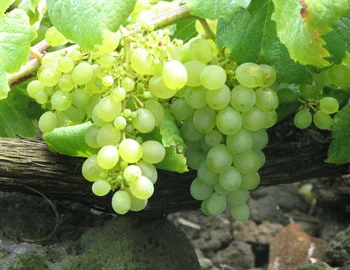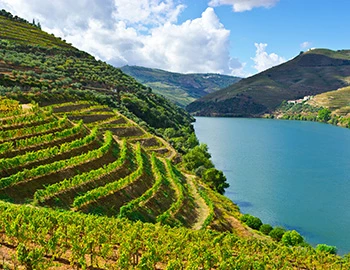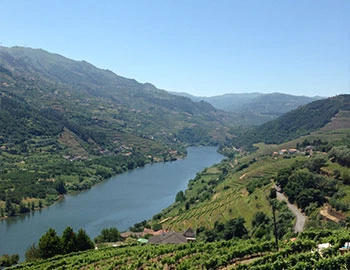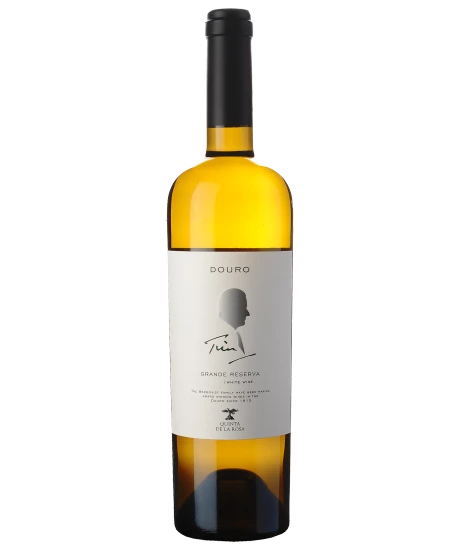Quinta de la Rosa Tim Grande Reserva white wine 2017
DOC Douro, 750 ml

Description
On the nose, very delicate and subtle where the mineral component dominates together with white fruit and floral impressions. On the palate, the wine is elegant, full of energy and complexity. Despite its richness and complexity, it is the wine’s fresh structure that stands out as being the most obvious characteristic of this wine. Its excellent acidity gives the wine great length and a wonderfully clean finish.
Attributes
| Grape variety: | Viosinho, Gouveio, Arinto |
| Producer: | Quinta de la Rosa |
| Origin: | Portugal / Douro |
| Other vintages: | 2019 |
| Label: | Vegan |
| Ripening potential: | 3 to 10 years |
| Drinking temperature: | 10 to 12 °C |
| Food Pairing: | Giant crevettes, grilled langoustines, Grilled fish, Succulent chicken breast with cream sauc, Spicy hard cheese |
| Vinification: | fully destemmed, soft pressing |
| Harvest: | hand-picking, strict selection |
| Maturation: | in new barriques, some months bottle storage before sale |
| Bottling: | filtration |
| Volume: | 12.5 % |
| Note: | Contains sulphites |
Quinta de la Rosa
Portugal and England have engaged in wine trading since the 14th century. Over the course of time, the British also settled in Portugal, establishing agricultural estates (quintas) to grow wine, and founding large trading companies in Porto. The Bergqvist family are descendants of these settlers, still involved in production and trade on the strength of innovative ideas and great commitment.
Quinta de la Rosa is headed by Sophia Bergqvist. She is the granddaughter of Claire Feuerheerd, who received Quinta de la Rosa as a christening gift from her English grandmother. Sophia's father, Tim Bergqvist, took over the management in 1972, after Claire Feuerheerd’s death. The quinta experienced some turbulent times – the depression in the 1930s, the Second World War and difficult times in the 1960s. When the Portuguese revolution broke out, the temptation to sell was great. But Sophia's mother, Patricia, spoke out strongly against this move.
With Portugal’s entry into the European Community in 1986, both father and daughter decided to join forces to make Quinta de la Rosa one of the leading independent producers of quality port wine. Very soon afterwards, Quinta de la Rosa became one of the first to also bottle dry Douro wine. Today, not only can you find their excellent port wines in the best wine shops, hotels and restaurants all over the world, but also their extraordinary dry white and red wines. The La Rosa White Wine Reserva, for example, surprises with its mineral freshness, complexity and length, standing toe to toe with top Burgundy wine.
The Douro Valley is also a fantastic travel destination. Quinta de la Rosa offers visitors charming rooms, equipped with all the modern comforts. In summer 2017, they opened the Cozinha da Clara restaurant, which serves Portuguese dishes and recipes handed down from grandmother Claire. www.quintadelarosa.com

Gouveio
The stranger stong in alcohol
This white grape variety hails from Portugal, where it is planted on around 2,500 hectares. Interestingly, this grape is virtually unknown outside of Spain, yet is also found on the Crimean Peninsula and in the Ukraine. Gouveio is represented in Australia, as well, where it is planted on around 200 hectares.
The grapes provide rich wines and present a moderate acidity, so Gouveio is often used in the production of white port and Madeira wines.

Viosinho
Loved from Alentejo to the Azores
This ancient, northern Portuguese white wine variety with pronounced acidity has very few references in the literature. It was first mentioned in 1822, albeit under a different name. The first citation using the name Viosinho dates from 1900.
According to DNA analysis, this vine is related to the Lado, Tinta Francisca, and Tinta Cão varieties.
This early-ripening grape is uncomplicated and robust. It yields aromatic white wines with pronounced acidity and potential for aging. Viosinho is often also referred to as “Portuguese Sauvignon Blanc.”
It is mainly grown in the Douro, Peninsula de Setubal, Tejo and Tras-os-Montes regions, as well as in the Alentejo and the Azores.

Douro
Douro: from port wine to cult wine
For centuries, the legendary reputation of the Douro valley has rested on port wine. By 1970, the five best had been selected from dozens of long-established varieties to be grown on a large scale. Simultaneously, the Douro vintners created the conditions that today allow them to conquer export markets with concentrated and fruity red wines along with port wines. The unique terraced vineyards along the Douro were declared a UNESCO World Heritage Site in 2001.

Portugal
Portugal – Much more than port
Situated on the southwestern tip of Europe, this country is, despite its small size, blessed with a multitude of landscapes. Austere mountains alternate with green valleys and golden beaches. Vines have thrived against this backdrop for over 4,000 years, brought to the peninsula by Phoenicians, Greeks, and Romans.
Portugal has over 500 autochthonous varieties. The term derives from ancient Greek, and means roughly “of the land itself.”



